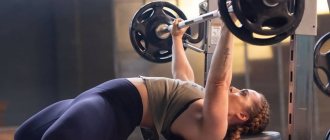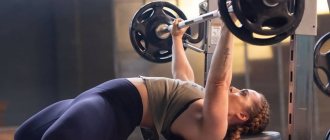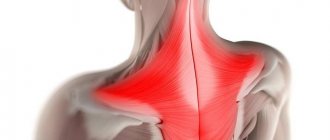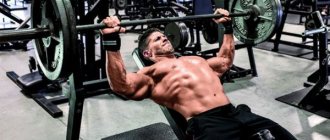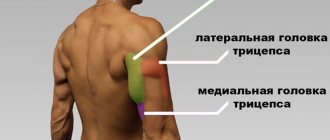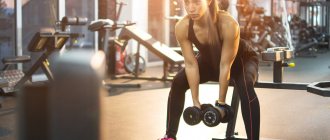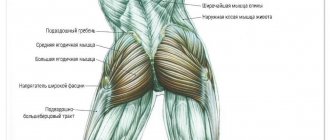Home ▸ Articles ▸ Workouts ▸ The best exercises for the lower chest for training in the gym and at home
If you've been working out at the gym for several years and have made significant progress in building your muscle core, you can rest assured that you've paid in full and earned some perks. One of them is not to take advice from others on how to train (you are quite experienced and clearly know what you are doing). Another is the ability to walk to the cooler between sets without fear of someone taking over your machine (muscles are a great defense against intrusion on your territory).
An intermediate-level guy or girl can target specific areas of the muscle to give it the desired size, such as training the lower chest to focus on the rib region of the pectoralis major muscle. While a beginner may want to focus on the basic bench press exercises to activate all of the chest muscles, a more experienced lifter may need to work the rib pecs directly to further progress in their training.
Well-developed pectoral rib muscles add volume to the lower chest, allowing it to stand out from the chest. This is rarely seen outside of bodybuilding competitions and means a high level of training.
Here's our best workout plan for enlarging your lower chest, but keep in mind: It's probably not what you're expecting.
What muscles are in the lower chest?
To understand how to train the lower chest, we must look at how it is designed and how it functions. When lifters say they want to target their “lower chest” with a particular exercise, they are talking about targeting the costal head of the pectoralis major muscle. Note that most anatomical diagrams identify the lower portion of the pectoral muscles as part of the "sternocostal head" of the muscle, but hypertrophy researcher Chris Beardsley says that based on how these muscles work, the pectoral and costal muscles should be divided into separate areas of work.
To understand what movements you need to train a particular muscle, all you have to do is look in the direction the muscle fibers are moving and know that when they contract, they will pull the insertion point (where the muscle attaches) closer to the origin point (where the fibers come from). For example, sternal fibers of the pectoral cle
The tissues (those in the middle part of the muscle) run straight horizontally, originating from the sternum and attaching to the humerus (upper arm bone). This means that these muscles contract to pull the shoulder straight across the front of the body. Thus, swings and bench presses primarily target the muscle fibers of the chest.
However, the costal (lower) fibers run from the cartilage of the sixth rib and the connective tissue on the external oblique root to the top of the humerus. The direction of the fibers is thus diagonal and even almost straight vertical, so they work more to pull the arms from where they are, away from the body, towards the front of the body and close to your sides (shoulder adduction). They also work to bring the arms from a position directly above the head to a position in front of the body (shoulder extension).
What to remember
There are 4 main approaches to training major muscle groups:
- Push-pull-legs.
- Training antagonist muscles.
- One muscle group per workout.
- Fullbody.
It is very difficult to say which of these approaches is better. The most important thing that determines results is not what muscles you train together, but the intensity and volume of load per week. Arnold Schwarzenegger often used antagonist muscle training, as well as the system - one muscle group per day. It was effective for him. But the best way is different for everyone!
Benefits of Lower Chest Workout
Strengthening the chest can help the muscles rise above the rib cage more, rounding out the lower part of the chest. Carter also believes that lower chest training has value for powerlifters.
“If you bench with a shoulder-width grip in competition,” he says, “the rib pectorals will contribute to that lift. So strengthening that part of your pecs will help you in the bench press.” In fact, Carter says that working your lower chest through push-ups, along with training your triceps, should probably make up the majority of your accessory work on the bench press.
Perfect lower chest workout in the gym
The rib region of the pecs is a fairly small area, and most of the chest work you do (press exercises and swings) will activate it to some degree, so don't overdo it when trying to pump up your lower chest. One or two exercises for her per workout should be enough. Here are some workouts to make your lower chest bigger.
Workout A
If you train each body part separately and have a specific pec day, you can prioritize your rib pecs by training them first while you're still strong. Then you can work on the rest of the chest (upper and middle) as shown below.
Use several warm-up sets to build up a weight that will allow you to perform a given number of repetitions, and then take that set to failure (the point at which you cannot perform another repetition). For rib push-ups, you can warm up with push-ups. If you are very strong at push-ups, you may need to add weight using a push-up/pull-up belt or hold dumbbells between your feet to reach failure at 6-10 reps.
1.Push-ups (lower chest)
Approaches: 1
Repetitions: as many as possible
Reduction of the upper blocks (lower chest)
Approaches: 1
Repetitions: as many as possible
Reduction of lower blocks (upper chest)
Approaches: 1
Reps: 12–15
Step 1: Set the handles on both sides of the crossover to the lowest pulley position. Grab the handles and step forward to lift the weight to create tension in your pectoral muscles. If you don't have access to a crossover, use resistance bands attached to a stand or other sturdy object.
Step 2. For stability, spread your feet, extend your arms diagonally to the floor, in line with the cables (everything is correct here), but maintain a slight bend in the elbows. Palms face forward. Keep your torso straight and still throughout the movement.
Step 3: Squeeze your pecs to raise your arms up in front of you. The upward movement should coincide with the clavicular fibers of the upper ribcage—think: diagonal.
Step 4: In the top position, your hands should touch each other at approximately face level, with your wrists in line with your forearms. Squeeze the top position for 1-2 seconds and then lower the controlled weight back to the starting position.
Dumbbell bench press (medium chest)
Approaches: 1
Reps: 15-20
Step 1. Take a dumbbell in each hand and lie down on a flat bench, placing the weights at shoulder level. Rest your lower back on the bench and tighten your core muscles.
Step 2: Push the dumbbells straight from your chest and hold.
Workout B
Here, you'll start with an incline press for your upper chest—usually a weak area—and then do two exercises for your lower chest, back to back. Rows are performed last, when the pectoral muscles are fully warmed up and filled with blood. An exercise that forces the muscles to stretch that much should never be done first in a workout—put it at the end for safety reasons.
Use several warm-up sets to build up a weight that allows you to perform a given number of repetitions, and then take that set to failure (the point at which you cannot perform another repetition).
Incline Dumbbell Press
Approaches: 1
Reps: 6–10
Step 1: Set your adjustable bench at a 30-45 degree angle. Grab a pair of dumbbells and lie back on the bench, making sure your back is in contact with it—don't arch your back so much that your lower back lifts off the surface.
Step 2: Start with dumbbells on the outside of your shoulders, elbows bent and forearms/wrists in a semi-pronated or neutral position (palms facing in).
Step 3: Keeping your elbows at about a 45-degree angle, press the dumbbells straight up until your arms are almost completely locked out. Lower the dumbbells down until they are just above your shoulders.
Dips.
Approaches: 1
Repetitions: as many as possible
Dumbbell rows.
Approaches: 1
Reps: 8–12
Workout C
Many lifters like to follow a push/pull/legs section, where they work all the pushing muscles on one day (chest, shoulders, triceps), pulling muscles on another (back, biceps), and practice exercises for the quads, hamstrings, and caviar in the third. In this case, your push day can begin with some costothoracic work.
Use several warm-up sets to build up a weight that allows you to perform a given number of reps, and then take that set to failure (the point at which you cannot perform another repetition).
Weighted dips
Approaches: 1
Reps: 6–10
Increase your body weight with a push-up/pull-up strap or hold dumbbells between your feet.
Dumbbell Bench Press
Approaches: 1
Reps: 12–15
Dumbbell lateral raises
Approaches: 1
Reps: 8–12
Step 1: Hold a dumbbell in each hand and bend your legs so that your lateral deltoid (middle head of the shoulder) is perpendicular to the floor.
Step 2: Raise the dumbbells outward 90 degrees.
Bent-over dumbbell lateral raises
Approaches: 1
Reps: 15–20
Step 1: Hold a dumbbell in each hand and bend your legs so that your torso is almost parallel to the floor. Maintain a straight line from your head to your pelvis and tighten your core muscles.
Step 2: Raise your arms to the sides.
Overhead triceps extension.
Approaches: 1
Reps: 8–12
Step 1: Attach the strap to a sturdy object above your head and grasp one end with each hand. Step away from the anchor point and raise your arms above your head. Place your feet shoulder-width apart. Push your hips back to tighten the band.
Step 2: Extend your elbows without moving your arms or body. Alternate your front foot on each set.
Examples of training schemes
Well-known experts have developed 4 basic schemes for effective training.
Within each category, there are dozens of different variations and combinations of exercises designed to work specific soft tissues. The scheme should be developed on an individual basis, depending on the individual characteristics of the human body, his physical fitness, goals and the amount of time spent in the gym.
If you have difficulties in independently selecting suitable exercises, it is recommended to seek help from a professional.
Improve your upper body program by effectively using chest and back supersets on the same day.
Gaining muscle mass is not an overnight miracle; it requires many years of dedication to the sport. But what would you say if you found out that you can achieve the desired results in half the time? Too good to be true, isn't it? In this article you will learn how to pump up your back and chest by working these muscle groups in one workout.
The perfect lower chest workout at home or without weights
You can target your lower chest without any special equipment, but we recommend purchasing some exercise bands and finding a way to set up a push-up station (two sturdy chairs or park bars may work).
Dips.
Approaches: 1
Repetitions: as many as possible
Bringing your arms together from top to bottom with an elastic band
Approaches: 1
Repetitions: as many as possible
Push-ups with legs elevated
Approaches: 1
Repetitions: as many as possible
Step 1: Place your hands on the floor, shoulder-width apart, and raise your legs behind you on a bench, box, or other stable surface. Tuck your tailbone slightly to keep your pelvis in a neutral position and tighten your core. Your body should form a straight line.
Step 2: Lower your body by tucking your elbows approximately 45 degrees to your sides until you feel a stretch in your pecs. Lift back, allowing your shoulder blades to open at the top.
Raising arms with an elastic band at shoulder level.
Approaches: 1
Repetitions: as many as possible
Main principles of combination
Each person is individual, therefore, for some, 1-3 workouts per week is enough, and for some, 5 sessions are not enough.
There must be moderation in everything. After grueling workouts, muscle fibers and bone tissues must fully rest and recover, otherwise you should not expect obvious progress. It is recommended to include abdominal training at the end of each workout, so exercises for abdominal training will not be noted below in the diagrams. To achieve the desired results, you need to take note of the correct sequence of exercises:
- shoulders;
- pectoral muscles;
- trapezium and neck;
- back extensors;
- biceps;
- triceps;
- legs (in this case we are talking about the buttocks).
Main rules for combining training
Basic rules for combining training developed by professional athletes:
- During one workout, you can work out the biceps and triceps muscle tissue along with the triceps.
- Abdominal exercises can be combined with all groups, so it is recommended to leave it “for a snack” at the end of each workout.
Working out the pectoral muscles and triceps in one day gives good results.
Technical training of the pectoral muscles and triceps in one day will allow you to quickly see good results. It is also recommended to combine training of biceps and deltoids with triceps.- It is not recommended to pump your shoulders together with the pectoral groups, since during training the deltoids will be very tired, especially the front ones. This combination must be excluded in the training process: the tissues will be overstrained and their growth will not be observed.
- A day of biceps and back training can be combined with forearm training. They are rarely indicated in the diagrams, since according to statistics, no more than 5% of all gym visitors use them.
- If you combine training of triceps and biceps with any other group, they must be moved to the very end of the training process, since hammering your arms will not allow you to effectively work out all the other muscle fibers, for example, the chest or back. The only exception is that the entire workout is devoted exclusively to the arms.
Why only 1 approach?
You may be surprised that in these workouts we only recommend one set of each exercise, when you've probably heard for years that 3 or more sets are more optimal. Scientists are still debating how many sets are needed to grow muscle, but Carter's experience has led him to believe that one hard set—pushed to failure—is all that's needed. This is supported by a study published in the Journal of Strength and Conditioning Research, which showed that only three complete sets per muscle group PER WEEK were enough to produce muscle gains, and the gains were equal to those measured in athletes who performed as many as 12 approaches!
The researchers wrote: “Hypothetically, both low- and high-volume training may result in microtrauma to muscle fibers, but high-volume training requires additional effort and time...
“Equality in lower- and upper-body strength development... indicates that when a minimum (threshold) level of strength training volume is performed at higher intensities, subsequent physiological adaptations may be optimized and additional workloads (e.g., 12 sets per muscle group) per week) do not contribute to further improvements, at least during the short training period.”
In other words, do 1 set of lower chest exercises to failure, then leave the gym!
Training schemes taking into account the main rules of combination.
The listed examples of combinations of groups will allow you not only to gain muscle mass, but also to lose weight and get rid of excess calories.
For more efficient calorie burning, it is recommended that you familiarize yourself with the methods of circuit training in more detail. Their essence is to perform several exercises without stopping, breaks are allowed only in the intervals between sets.
